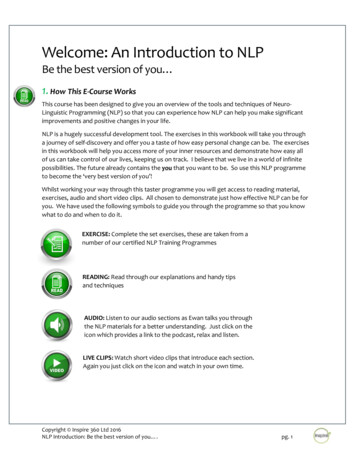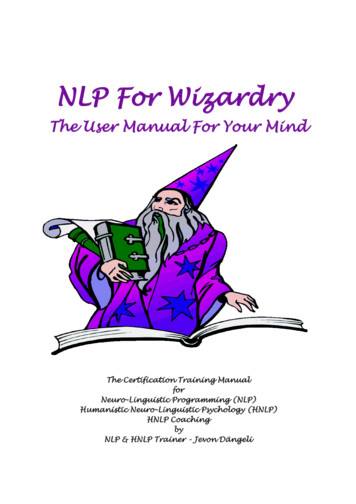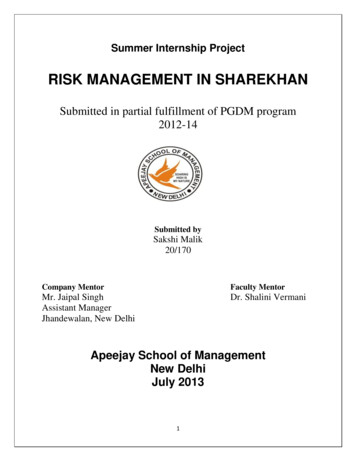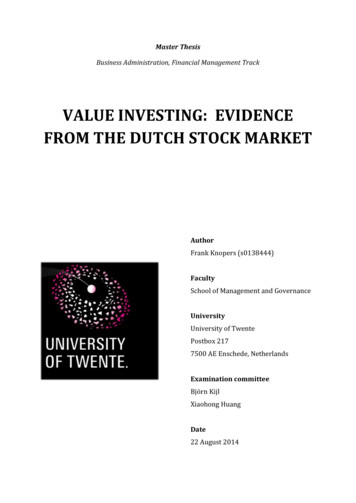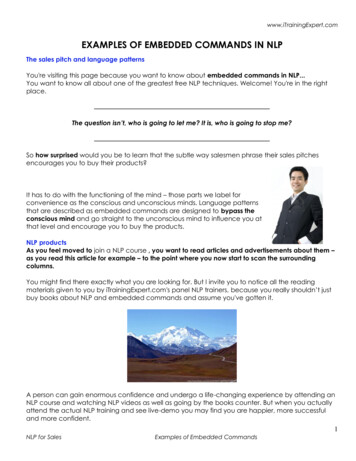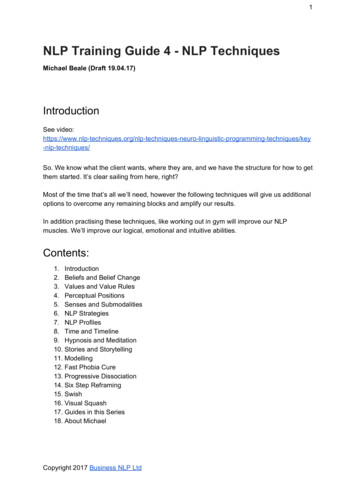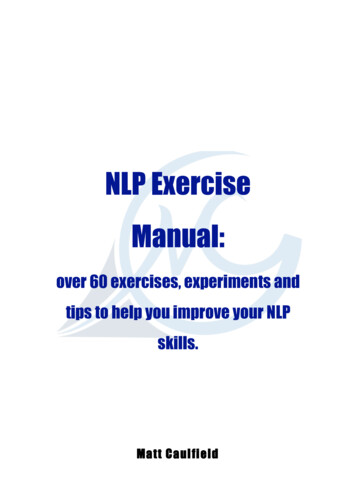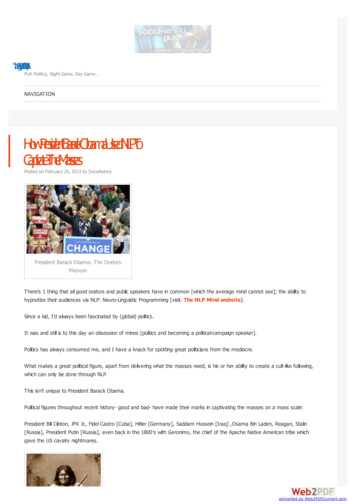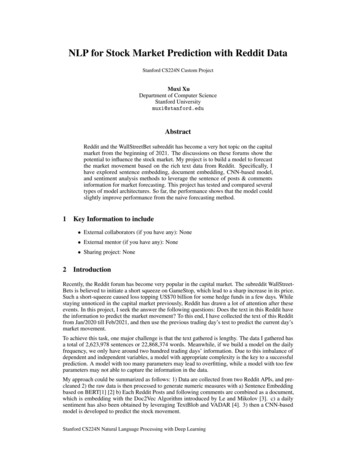
Transcription
NLP for Stock Market Prediction with Reddit DataStanford CS224N Custom ProjectMuxi XuDepartment of Computer ScienceStanford Universitymuxi@stanford.eduAbstractReddit and the WallStreetBet subreddit has become a very hot topic on the capitalmarket from the beginning of 2021. The discussions on these forums show thepotential to influence the stock market. My project is to build a model to forecastthe market movement based on the rich text data from Reddit. Specifically, Ihave explored sentence embedding, document embedding, CNN-based model,and sentiment analysis methods to leverage the sentence of posts & commentsinformation for market forecasting. This project has tested and compared severaltypes of model architectures. So far, the performance shows that the model couldslightly improve performance from the naive forecasting method.1Key Information to includee External collaborators (if you have any): Nonee External mentor (if you have any): Nonee Sharing project: None2IntroductionRecently, the Reddit forum has become very popular in the capital market. The subreddit WallStreetBets is believed to initiate a short squeeze on GameStop, which lead to a sharp increase in its price.Such a short-squeeze caused loss topping US 70 billion for some hedge funds in a few days. Whilestaying unnoticed in the capital market previously, Reddit has drawn a lot of attention after theseevents. In this project, I seek the answer the following questions: Does the text in this Reddit havethe information to predict the market movement? To this end, I have collected the text of this Redditfrom Jan/2020 till Feb/2021, and then use the previous trading day’s test to predict the current day’smarket movement.To achieve this task, one major challenge is that the text gathered is lengthy. The data I gathered hasa total of 2,623,978 sentences or 22,868,374 while, if we build a model on the dailywe only have around two hundred trading days’ information. Due to this imbalance ofand independent variables, a model with appropriate complexity is the key to a successfulA model with too many parameters may lead to overfitting, while a model with too fewmay not able to capture the information in the data.My approach could be summarized as follows: 1) Data are collected from two Reddit APIs, and precleaned 2) the raw data is then processed to generate numeric measures with a) Sentence Embeddingbased on BERT[1][2] b) Each Reddit Posts and following comments are combined as a document,which is embedding with the Doc2Vec Algorithm introduced by Le and Mikolov [3]. c) a dailysentiment has also been obtained by leveraging TextBlob and VADAR [4]. 3) then a CNN-basedmodel is developed to predict the stock movement.Stanford CS224N Natural Language Processing with Deep Learning
3Related WorkThere are many papers on extracting information from sentences and documents. Sanjeev, YingyuLiang, and Tengyu [5] has proposed a method to use a weighted average of work vectors to generatethe sentence representations. Zhe, Yunchen, Ricardo Henao, et al. [6] has developed a model withCNN and LSTM to encode sentences. Ryan, Yukun, Ruslan, et al. [7] uses the continuity of text totrain an encoder-decoder model and then uses the vector obtained to represent the sentence. BERThas also been used in sentence representations. Sentence-BERT [2] provides a modification of thepre-trained BERT network that uses siamese and triplet network structure to derive semanticallymeaningful sentence embeddings. Furthermore, Le and Tomas [3] introduces a paragraph vector thatenables the embedding of various length text like document or paragraph.There is also a lot of work on financial forecasting with the NLP method. Frank, Erik, and Roy [8]has done a review of recent papers in the field of natural language-based financial forecasting. Thispaper has reviewed the works in this field from the 1980s, and it also introduces some developmentsin using social media contents for forecasting. In the field of leveraging social media content, manypapers focus on using Twitter data because of its simple semantics and restricted length. Machinelearning methodologies have also been widely used in this field. Xioa, Yue, et al.[9] use the neuraltensor network and convolutional network to forecast S&P 500 index based on news text. [10] hasused the sentiment score on Twitter data to predict stock market movement.Some previous projects of CS230N also explored the area of financial forecasting with the NLPmethod. [11] has used sentiment embedding and document embedding to predict FRB rate changesfrom the FOMC meeting text. [12] uses the document embedding method to predict the well-knownFama French equity market factors. [13] uses an attention-based model on the company’s 8k reportto predict stock movement post-earnings.However, the Reddit event happens recently and perhaps is still developing. To the extend of myknowledge, there is not much research on building NLP models on these data, which is the goal ofmy project.44.1ApproachData ProcessingData processing is often an overlooked, but very important part of modeling. To facilitate the modeldevelopment, I have done the following data processing steps:e data pre-clean: with the data scrabbed from the Reddit API. I first did some preliminarydata cleaning such as remove links, special symbols, etc.e Ticker Data Extracting: with the pre-cleaned data, I apply a simple regular expression toextract all the ticker mentioned within each day.e Sentenece dataset: Still on the preliminary cleaned data, I use the nltk package to split allthe comments, posts, etc., into sentences.e Posts document dataset: With the sentence dataset developed, I further merged those textunder the same post together as a document. A subtlety here is we need to filter thosecomments based on timestamps to avoid any information leakage. For example, if any oftoday’s comments on yesterday’s post is mistakenly included, we may end up using futureinformation for prediction.e Model Target: Regarding the model target, I set my target as the market movement whichis calculated as Movement; I(Open; — Close).4.2Sentence EmbeddingWith the preliminary datasets created above, I have used the sentence transformer python package toget the sentence embedding based on the BERT method.[2] [1]. Based on the paper [2] , this SBERThas added pooling operations to derive the fixed size sentence embedding. To fine-tune the BERTmodel, the authors have also created siamese and triplet networks to update the weights. After thissentence embedding process, a vector with a size of 768 dimensions is created for each sentence.
4.3Document EmbeddingWhile sentence embedding is created, naturally I also explored the document embeddings. To achievea document level embedding. I have explored the following methods:CNN Model on Sentence Sampling: With the sentence embedding vector generated, avery straightforward way is to use a neural network to generate a vector that represents theinformation of a day. However, as described earlier, the number of sentences is differentfrom day to day. To solve this problem, I’ve tried to sample 500 sentences from each day’spost and use this as the input for the CNN model.Average of all Sentence: Another simple method I have tried is to take the simple averageof all the sentence vectors for each day.Doc to Vector on Posts documents: A third method I have tried is to use the document tovector method introduced by [3]. As described earlier, this method is developed based on adocument vector built in the model. For the document embedding, I have fit a model on thetraining data to obtain a vector of size 50.4.4Sentiment AnalysisInspired by [10], I have also tried to include those common sentiment analyses into my model. Twosentiment analysis has been tried, the Textblob and VADER.4.5Neural Network ModelWith all the above embedding and sentiment scores. I have developed couple of different neuralnetworks to forecast the final market movement. My models have four major components or modulesas in figure 1.Data Sampling: As described earlier, the length of documents varies from day to day. Toget a fixed length of data for model training. I have tried to sample a fixed number ofsentences or documents for each day. Currently, I have sampled 500 sentences and 10documents for each day. In addition, my early model result shows a serious problem ofoverfitting. Thus, I have also tried to do mulitple sampling for each trading day. My currentmodel is fitted on 5 samples from each trading day.Setnence CNN Module: This module takes the embedding vectors of the sentence and feedsthem to a CNN model. The ideal is to leverage the CNN model to extract the informationfrom embedding vectors.Sentence Averaging Moudule: The averaging module using simple averaging to combineall sentence vectors.Document Module: This module refers to using document embeddings instead of sentenceembedding for forecasting. Similar to the sentence embedding, a CNN model is used togenerate the forecast.Sentiment Analysis: This module takes the text of each day to generate a daily sentimentscore time series.With the above modules, I have built several models:Sentence CNN Model: This model uses a sentence CNN module and an FC layer to forecastthe market movement.Sentence Averaging Model: This model uses a sentence CNN module and an FC layer toforecast the market movement.Sentence CNN Sentiment Model: This model uses sentence CNN as well but before theFC layer. The sentiment score is added as well.Document CNN Sentiment Module: This model uses document CNNsentiment score right before the FC layer.Sentence Document CNN Sentiment Module:and adds theThis model uses almost all modulesincluding sentence CNN, document CNN, and sentiment scores.
Le) (-teh9FC Layer1!tCNN Layer 2i't.itVti 'utCNN Layer 1DCRti\i!t '1hre gs1"Embedding4oonpenn coeraoeeer eee naene1‘ )zHuertarot\ imTnnn el1)ema1 n1 EntMcpeeeeneersneeceeeemescemee!1ieee\!FIrn eeeaAveraging''aed"Feanlelste(e ay 41ottLlosmmessuenees!!!Sentence CNN ModuleFigure 1: Model StructureMarket Close Price Time Series AnalysisAutocorrelationPartial 305I40Sots{ lT05810a taet520tat2BttT30es540Figure 2: Closing Price Time Series Analysis4.6BaselineFor the baseline, I use the the most straightforward naive forecast method. As introduced in thisarticle [14], the most simple way is to use current market price or condition to forecast future. In mycase, the forecasting formula is:Movement; Movement; 1This sounds simple but works. As shown in the figures 2 and 3, the stock market price shows a strongcorrelation with historical performance.As we could see from the ACF/PACF analysis, the market price dataset shows a very strong autocorrelation pattern. While more complicated may be built, a simple AR1 method usually could generatea fair forecast.Market Movement Time Series AnalysisAutocorrelationPartial [Ieofot—obeeatorgeems TyI TTtTw10520330Sree6an40-02 0samaclel cas510aneTST6fTat2203Figure 3: Market Daily Movement Time Series Analysis2» ey30af%err40
55.1ExperimentsDataMy project needs two major data, the Reddit text data and the market price data.e Reddit Data: Fortunately, there are a lot of materials about grabbing data from Reddit. [] Ihave modified those code to grab the data from wallstreetbets. As a quick summary:————Time Range: Jan, 2020 to Feb, 2021Nubmer of Sentence: 2,623,978Nubmer of unique word: 427,160Maximum/median/ minimum length of sentence: 8,693/7/1e Market Data: SP500 index price data is downloaded from Yahoo Finance. This datacontains couple key columns including open price (OPEN), close price (CLOSE), max priceof the day (HIGH), min price of the day (LOW), volume of the day (VOLUME).5.2.Data Split & Evaluation methodMy model is built on time series data. A random split of train & test dataset may not be appropriate.Thus, I split my data to in and out of time. Specifically, I use all the data in 2020 as training and after2020 for testing. As the goal of my model is to forecast the movement of the market (up or down), Ijust use the accuracy ratio to evaluate the model, which is calculated as follows:accuracy S (Vyest Yaewual))/N5.3Experiment DetailsMy experiement setup is slightly different among models. But in generally, one typical CNN modulecontains one Conv2d layer, one Norm2d layer, one ReLU activation, one Max Pool and one dropout layer. For my Doc2Vec or Sentence2Vec model, it may contain one or two such modules. Forsentence average method, it only contains simple linear layers. The list belows shows some key itemsof my experiments:e training/Testing Period: Jan, 2020 to Dec 2020/Feb, 2021e Learning Rate: starts with 0.006 and deacy as more epochs.e Nubmer of Epoch: 400 to 650e training time: around 50 mins to 2 hourse CNNlayer type 1: kernel size: 3, stride 1, paddinge@ CNNlayer type 2: kernel size: 3, stride 1, padding , input channel 4, output channel 1,dropout 0.2 to 0.41, input channel 1, output channel 4,dropout 0.2 to 0.4e Linear Layer: 32 or 64 hidden nuerons.5.4Experiment ResultsAs a result of the experiments, table 1 shows the accruacy of in and out sample test. Some observationfrom the experiment result.e Model is able to improve the in-sample accuracy significantly. However, the improvementof out sample accuracy is not very significant.e Model is prone to over fitting problem. As we could see, for those relatively more complicated models, the in-sample accuracy is all above 90%.e Among all the models tested, the sentence embedding average model shows the best performance on the over-fitting aspect. Compared with other models, the difference betweenin-sample and out-sample accuracy is the smallest. I believe this model could be furtherimproved.
Table 1: Model Results#01MethodBaselineSentence Embedding Averaging ModelTraining Period47.9%61%Testing Period46%51.4%2Sentence Embedding CNN Model100%57%3Document Embedding CNN Model91%54%4Sentence Embedding CNN Sentiment Model93%30%5Document Embedding CNN Sentiment Model83%46%6Document & Sentence Embedding CNN Sentiment Model98%51%e TheOneFortime6overfitting problems shows that we may need more data to train complicated model.possible solution is to forecast single stock performance instead of the general market.this, I have done the analysis of the ticker frequency. However, I haven’t had enoughto finish the modeling on single stock level.ConclusionIn conclusion, the models based NLP method does provide better prediction than the naive forecasting method. My result also shows sentence embedding CNN model has the best out of sampleperformance. However, from the overfitting aspect, the more simpler averaging model shows thebetter potential for further improvement. During the project, there are couple items I have tried butdon’t have enough time to finish.e Single Stock Forecasting: a more reasonable assumptions is that the discussion on Redidtmay have a larger influence on specific stock like GME. I have extracted the ticker frequency from each day’s text data. We probably could build some models on these stocks’performance.e Higher Frequency: my current model is done on daily frequency.fitting problem, it may worth to try higher frequency like hourly.As we have the overReferences[1] Nils Reimers and Iryna Gurevych. Sentence-BERT: Sentence embeddings using SiameseBERT-networks. In Proceedings of the 2019 Conference on Empirical Methods in Natural Language Processing and the 9th International Joint Conference on Natural Language Processing(EMNLP-IJCNLP),pages 3982-3992, Hong Kong, China, November 2019. Association forComputational Linguistics.[2] Nils Reimers. Sentence transformers: Multilingual sentence embeddings using bert / roberta/xlm-roberta & co. with pytorch. In https://github.com/UKPLab/sentence-transformers, March2021.[3]Quoc V. Le and Tomas Mikolov.Distributed representations of sentences and documents, 2014.[4]Clayton J. Hutto and Eric Gilbert. InJICWSM.[5] Sanjeev Arora, Yingyu Liang, and Tengyu Ma. A simple but tough-to-beat baseline for sentenceembeddings. In ICLR, 2017.[6]ZheGan,YunchenPu, Ricardo Henao,ChunyuanLi, XiaodongHe, and LawrenceCarin.[7]Ryan Kiros, Yukun Zhu, Ruslan Salakhutdinov, Richard S. Zemel, Antonio Torralba, RaquelUnsupervised learning of sentence representations using convolutional neural networks. 2016.Urtasun, and Sanja Fidler. Skip-thought vectors. CoRR, abs/1506.06726, 2015.
[8] Frank Z. Xing, E. Cambria, and R. Welsch. Natural language based financial forecasting: asurvey. Artificial Intelligence Review, 50:49-73, 2017.[9] Pisut Oncharoen and Peerapon Vateekul. Deep learning for stock market prediction using eventembedding and technical indicators. pages 19-24, 08 2018.[10] Johan Bollen, Huina Mao, and Xiaojun Zeng. Twitter mood predicts the stock market. Journalof Computational Science, 2(1):1-8, 2011.[11]Ye Ye. Can fomc minutes predict the federal funds rate? 2020.[12] Andrew Han. Financial news in predicting investment themes. 2020.[13] Mohamed Masoud. Attention-based stock price movement prediction using 8-k filings. 2014.[14] Train2Test.2020.Statistical approach to stock price prediction: Naive forecast, moving average.
training data to obtain a vector of size 50. 4.4 Sentiment Analysis Inspired by [10], I have also tried to include those common sentiment analyses into my model. Two sentiment analysis has been tried, the Textblob and VADER. 4.5 Neural Network

